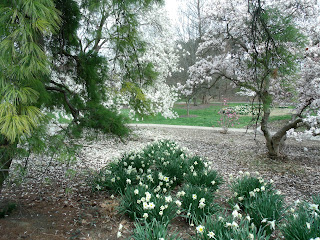St. Louis Cathedral, Jackson Square
Dear
George,
Our
family members live in or near lots of special places, e.g., New York City,
Seattle, Santa Cruz, Philadelphia, Princeton, San Francisco, Saranac Lake. But none is more extraordinary than New
Orleans. Our son and
daughter-in-law, J and K, moved there in the mid-1990’s, and now our sweet
grandchildren draw us there as well.
We’ve gone down at least once a year for quite a while. I plan to visit in a few weeks,
and, as part of my psychic preparation for taking in the city, I’ve assembled a
potpourri of informative and fun historical facts. Here’s a short account of NOLA from its beginnings:
1541:
The region was first visited by Europeans when a Spanish exploration party led
by Hernando de Soto discovered the Mississippi River.
1718: New Orleans (Nouvelle-Orléans),
just a trading camp at the time, was founded by Jean-Baptiste Le Moyne de
Bienville on the first crescent of high ground above the Mississippi’s mouth (a
hundred miles from the Gulf).
1718:
The first St. Louis Cathedral building was erected, and now it’s the oldest
continually operating cathedral in the U.S.
1721: Priest-chronicler Pierre François Xavier de Charlevoix
described New Orleans as “a place of a hundred wretched hovels in a malarious
wet thicket of willows and dwarf palmettos, infested by serpents and
alligators.”
1727:
The Urusuline nuns braved five months of high seas, pirates, shipwreck, and
sickness to come to New Orleans.
Their convent was finally completed seven years later.
1762
and 1763: France signed treaties ceding Lousiana to Spain, making New Orleans a
Spanish city for the next 40 years, trading heavily with Cuba and Mexico and
adopting Spanish racial rules that allowed for a class of free people of color.
1765:
Following the French and Indian War, Acadian immigrants from Canada (Cajuns)
began settling in French-colonized Louisiana, including New Orleans.
1788
and 1794: The city was ravaged by fires that destroyed 80% of its buildings,
then was rebuilt with brick buildings and a cathedral that are still standing
today.
1789:
New Orleans' earliest cemetery, St. Louis No. 1 at 3421 Esplanade Ave., was
established.
1791: With a population nearing 10,000, New
Orleans had twice as many tavern keepers as it did merchants.
1796:
The first opera in the U.S., Ernest Grétry's Sylvain, was performed in New Orleans on May 22.
1803:
To gain control of the vital Port of New Orleans, Thomas Jefferson negotiated
the Louisiana Purchase with Napoleon I of France for $23 million, thereby
doubling the land area of the United States.
1805:
New Orleans was incorporated as a city.
1805: A New Orleans census (probably
under-counted) showed a population made up of 3551 whites, 1556 free blacks,
and 3105 slaves.
1806: Named for its showy gardens, the
Garden District was laid out by Bathelemy Lafon as an open, semi-urban system
of interrelated parks with basins, fountains, and canals.
1813:
Governor Claiborne offered a $500 reward for the capture of legendary pirate
Jean Lafitte, whereupon Laffitte countered with a $1,500 reward for the capture
of Governor Claiborne.
1815:
Colonel Andrew Jackson led a coalition of free blacks, pirates, and Tennessee
Volunteers to defeat a British force outside the city in the final battle of
the War of 1812.
1815:
Charity Hospital was built.
1823: The first permanent theater in the
U.S., the American Theatre, was established in New Orleans by James Caldwell.
1823:
What is now the oldest existing pharmacy in America was built at 514 Chartres
Street in the French Quarter.
1827:
New Orleans' first Mardi Gras
("Fat Tuesday" in French) was celebrated.
1830:
Most New Orleans residents still spoke French.
1834:
Tulane University was founded in 1834 as the Medical College of Louisiana.
1835:
The New Orleans & Carrollton Line opened and remains the oldest street
railway line still in operation in the country.
1837:
The Picayune newspaper began its publication.
1840:
Antoine's Restaurant opened for business.
1850s: New Orleans was the third largest city
in the nation with a population of 166,375.
1853: City Park was established.
1862:
The city was captured and occupied by Union forces during the Civil War.
1862:
Cafe du Monde opened for business at the French Market.
1866: New Orleans
successfully operated a racially integrated public school system during the
Reconstruction era.
1871:
Santa became the first Mardi Gras thrower when he rode in the Twelfth Night
Revelers parade and passed out gifts to the children in the crowd.
1872: In order to entertain Grand Duke Alexis
Romanoff of Russia, Rex became the city's first krewe to stage an elaborate
daytime parade.
1873:
The first parade constructed entirely in New Orleans was Comus 1873, built by
George Soulé. Earlier New Orleans
parade floats in the 1860s were built partially in Paris and finished in New
Orleans.
1874: Armed forces led by White League
segregationists defeated the racially integrated metropolitan police and their
allies in an intense battle in the French quarter and along Canal Street,
forcing the temporary flight of the governor and his administration.
1877:
Buddy Bolden was born, an early jazz musician who music historians credit as
the inventor and first bandleader of jazz from 1895-1907.
1881: Voodoo priestess Marie Laveau died at
age 98 after influencing tens of thousands of multiracial followers since the
early 1830s through her legendary rites.
1886: New Orleans philanthropist Josephine
Louise Le Monnier Newcomb created Newcomb College, the first degree-granting
university for women in the U.S.
1897:
City alderman Sidney Story wrote legislation setting up the legalized red-light
district known as Storyville in order to limit prostitution to one area of
town. Storyville's black and white
brothels, venues for many of the era’s great jazz musicians, flourished until
shut down in 1917.
1919: Louis Armstrong, age 18, replaced King
Joe Oliver in Kid Ory's jazz band.
1933:
Pat O'Brien's Bar opened on St. Peter Street at the end of Prohibition.
1934: The Live Oak Society was founded. Composed entirely of trees with the
exception of an honorary human chairman, each member tree is required to pay
dues of 25 acorns per year.
1938:
Tennessee Williams arrived in New Orleans, and less than a decade later "A
Streetcar Named Desire" became the most famous New Orleans literary work.
1950: Fats Domino Jr., born in New Orleans in
1928, had his first major hit with “The Fat Man” (Imperial Records).
1953:
Café Lafitte in Exile opened on Bourbon Street, the oldest gay bar in the
country.
1956: LSU-New Orleans was established.
1960:
The school desegration crisis branded the city as a stronghold of racism, and
whites began relocating to the suburbs in huge numbers.
1967:
The New Orleans Saints football team was formed.
1970:
Jazz Fest had its first season.
1975:
The Superdome opened, the largest fixed dome structure in the world.
1977:
Tipitina’s music club, which has hosted the likes of the Neville Brothers,
Kermit Ruffins, James Brown, Bonnie Raitt, Pearl Jam, and innumerable other
artists, opened on Napoleon Ave. in Uptown.
1978: City Councilman Ernest N.
Morial became New Orleans’ first African-American mayor.
2005:
Hurricane Katrina hit New Orleans, 80% of the city was flooded after the city's
levees failed, and total economic losses in the region were estimated at $100
billion.
2010:
The city's population rebounded to 343,829 after a post-Katrina low of about
223,000 in 2006.
All
in all, New Orleans’ history offers a portrait that testifies to its uniqueness
among American cities: ethnic and cultural diversity, European heritage,
extremes of wealth and poverty, Deep South elegance mixed with cosmopolitanism
and tolerance, abundant nightlife, jazz, booze and drugs, sex, crime and
corruption, racial conflict, Catholicism, voodoo, gay-lesbian culture,
literature and the arts, theater, international commerce, ghost and vampire
stories, and a legendary past. I’m
eager to be off on my trip and will file a travel report when I get back.
Love,
Dave
G-mail Comments
-Donna D
(5-1): david, this is great! as your psychic compadreista i can't wait to
hear about your adventures! donna
-Linda C
(4-23): Thanks , send pics and have a great time.














































































































































































































